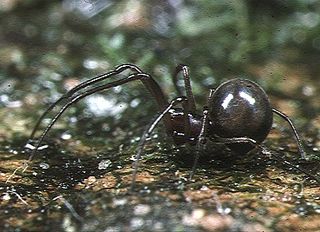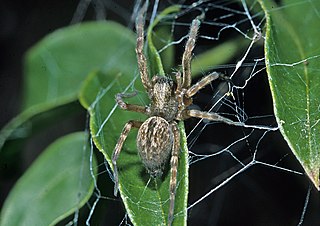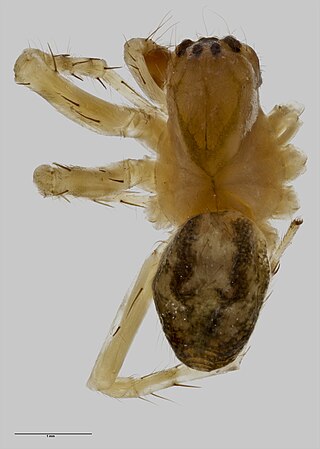
Anapidae is a family of rather small spiders with 232 described extant species in 58 genera. It includes the former family Micropholcommatidae as the subfamily Micropholcommatinae, and the former family Holarchaeidae. Most species are less than 2 millimetres (0.079 in) long.

Badumna is a genus of intertidal spiders that was first described by Tamerlan Thorell in 1890. They are harmless spiders that can be found around human structures and buildings. The most well-known species is B. insignis, also known as the "black house spider" or "black window spider".

The New Zealand pipit is a fairly small passerine bird of open country in New Zealand and outlying islands. It belongs to the pipit genus Anthus in the family Motacillidae.
Laetesia amoena is a species of sheet weaver found in New Zealand. It was described by Millidge in 1988.
Laetesia minor is a species of sheet weaver endemic to New Zealand.
Laetesia prominens is a species of sheet weaver spider found in New Zealand.

Laetesia paragermana is a species of sheet weaver endemic to New Zealand.

Laetesia pseudamoena is a species of sheet weaver endemic to New Zealand.

Oramiella is a genus of South Pacific funnel weavers containing the single species, Oramiella wisei.

Zeatupua is a monotypic genus of araneomorph spiders in the family Physoglenidae containing the single species, Zeatupua forsteri. It was first described by Fitzgerald & Sirvid in 2009, and is found in New Zealand.
Poecilafroneta is a monotypic genus of Polynesian sheet weavers containing the single species, Poecilafroneta caudata. It was first described by A. D. Blest in 1979, and has only been found in New Zealand.
Hexathele exemplar is a species of mygalomorph spider endemic to New Zealand.
Hexathele taumara is a species of mygalomorph spider endemic to New Zealand.
Diploplecta communis is a species of Linyphiidae spider that is endemic to New Zealand.
Diploplecta simplex is a species of Linyphiidae spider that is endemic to New Zealand.

Haplinis tokaanuae is a species of sheet weaver spider endemic to New Zealand.

Metamynoglenes helicoides is a species of sheet weaver spider endemic to New Zealand.
Toxopsiella orientalis is a species of Cycloctenidae spider endemic to New Zealand.

Toxopsiella perplexa is a species of Cycloctenidae spider endemic to New Zealand.
Alistra mangareia is a species of Hahniidae spider endemic to New Zealand.









